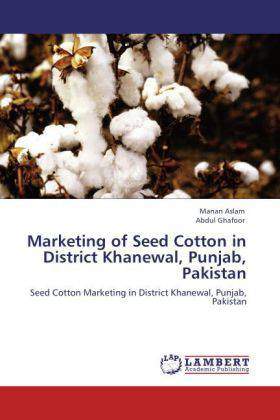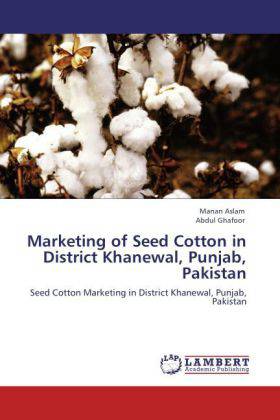
- Afhalen na 1 uur in een winkel met voorraad
- Gratis thuislevering in België vanaf € 30
- Ruim aanbod met 7 miljoen producten
- Afhalen na 1 uur in een winkel met voorraad
- Gratis thuislevering in België vanaf € 30
- Ruim aanbod met 7 miljoen producten
Zoeken
Marketing of Seed Cotton in District Khanewal, Punjab, Pakistan
Seed Cotton Marketing in District Khanewal, Punjab, Pakistan
Manan Aslam, Abdul Ghafoor
Paperback | Engels
€ 48,45
+ 96 punten
Omschrijving
Cotton, known as 'white gold', is an important cash crop in Pakistan. The Pakistani cotton industry is a vital component of the country's economy, accounting for 1.6 % of Gross Domestic Product. Cotton was cultivated on an area of 3.19 million hectares, with production of 11.7 million bales for the year 2008-09. However cotton marketing and pricing system in the country is not developed and both the seed cotton and lint cotton are priced mostly on the basis of subjective assessment. The major problems facing the country's cotton sector include the absence of a recognized and scientifically devised standardized quality control system, inappropriate marketing practices and fluctuating marketing arrivals. Khanewal is the important, production region in the cotton belt in Pakistan. So keeping in view its importance Khanewal district was selected purposively and then two tehsils (Khanewal tehsil and Kabirwala tehsil) were selected randomly. A representative sample of 40 cotton farmers, 20 commission agents, 20 village beoparies and 20 ginners was selected using stratified random sampling technique. The descriptive statistics was used to calculate the frequencies and percentage of sample
Specificaties
Betrokkenen
- Auteur(s):
- Uitgeverij:
Inhoud
- Aantal bladzijden:
- 104
- Taal:
- Engels
Eigenschappen
- Productcode (EAN):
- 9783845443720
- Verschijningsdatum:
- 23/11/2011
- Uitvoering:
- Paperback
- Formaat:
- Trade paperback (VS)
- Afmetingen:
- 152 mm x 229 mm
- Gewicht:
- 163 g

Alleen bij Standaard Boekhandel
+ 96 punten op je klantenkaart van Standaard Boekhandel
Beoordelingen
We publiceren alleen reviews die voldoen aan de voorwaarden voor reviews. Bekijk onze voorwaarden voor reviews.











